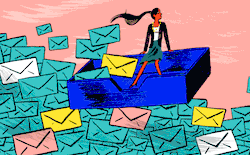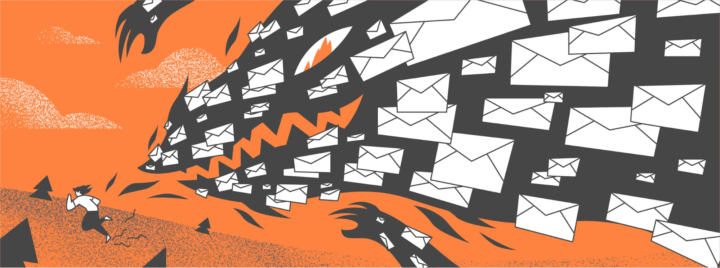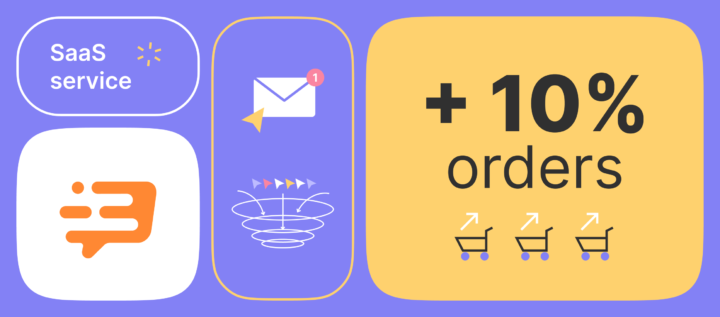How to make a good email campaign and not get flagged as spam
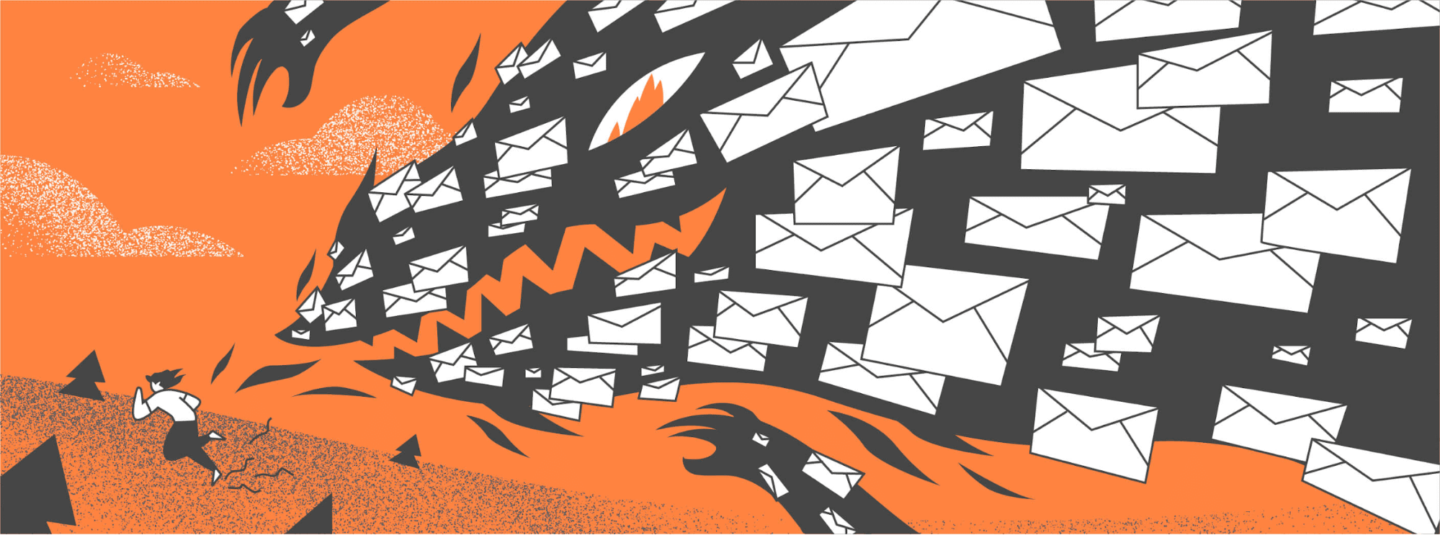
Email marketing providers mostly rely on behavioral factors. If your email recipients flag your messages as spam too often, mailing services will quickly learn to treat you as a spammer.
Spam flagging algorithms are kept secret by mailing services, but this list of recommendations will keep you from making common email marketing mistakes and help you avoid getting flagged by spam filters.
Thanks! The first email is already in your inbox

Working with your email base
1. Build your own email base; don’t just buy a pre-gathered one
An email address is something very personal to people: when you send a message to a person’s inbox, you’re stepping on their territory and seizing their attention. People don’t just leave their email address in random places, because no one likes uninvited guests. People want to be in control of who can and who can’t message them.
That’s why the email conversion rate on your website is relatively low and usually hovers at around 1-2%. You can give it a slight boost by using marketing automation and special automation scenarios.
But now, imagine you somehow find a person’s email address and invade their personal space. This person definitely won’t be happy to see you there (even if you think your revolutionary product is guaranteed to make everyone a happier person). So, just don’t do it. Besides, pre-gathered email bases often contain a lot of invalid email addresses.
One of the simplest ways to gather your own email base is to launch automated pop-ups with email input fields. These pop-up windows will draw the attention of your visitors and increase the conversion rate. This will be even more effective if you give your visitors something in return for their email addresses, like a gift or a discount.
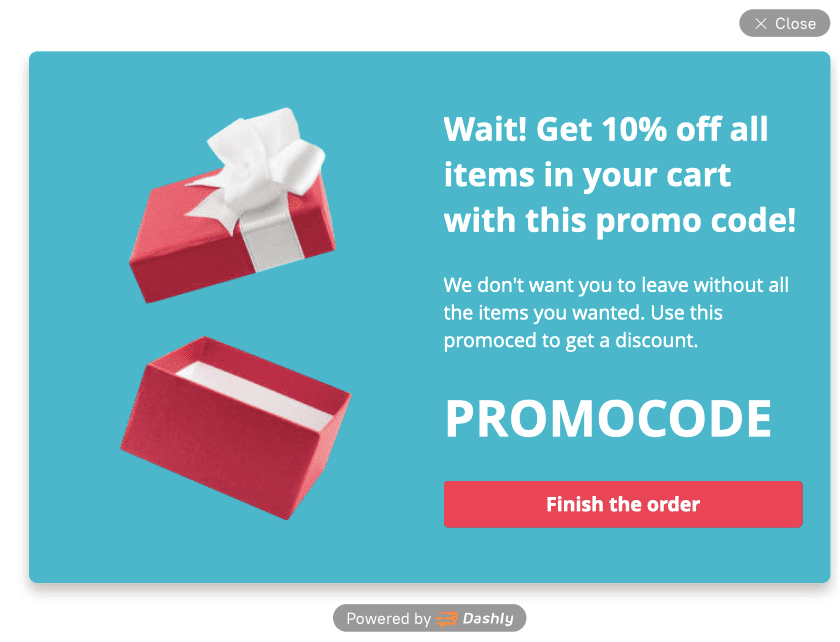
The email conversion rate of this type of pop-up is 5,5%, which means that 55 out of 1000 people who see this pop-up leave their email address in it. This is an excellent result.
2. Validate your email base
Email validation will confirm that your email base does, in fact, have invalid email addresses and will help you avoid a high bounce rate (which happens when your emails don’t reach their destination). This will keep you from being accused by mailing services of spreading spam.
It’s important to check your email base for spamtraps. Spamtraps are email addresses that mailing services use to manage spammers. There are two kinds of spamtrap:
- True — email addresses that were made to be spread across the web for spammers to parse them;
- Recycled — email addresses that haven’t been used for a long time and have been repurposed as spamtraps (which makes sense — who would keep sending their email campaigns to abandoned email addresses?).
Luckily for us, there are services that can help us check our email base and clean it of unused email addresses and spamtraps.
Here’s what they usually check:
- The format and syntax of an address. If an email looks like this: abcde#gmailcom, it will get filtered. Dashly can filter such emails too.
- Domain and server. At this step, services check if an address is held by an actual domain and if it’s able to receive email messages.
- Email condition. At this step, services check if an email address exists and if it’s currently in use.
3. Enable Double Opt-in
Double Opt-in is a two-step confirmation system required to be performed by users.
This system sends a confirmation email with a special URL to each email address left by users. By clicking on this URL, users confirm that this is their email and that they’re willing to receive your email messages. If a user doesn’t follow both steps of confirmation, they won’t receive any more email messages from you.
Double Opt-in does, indeed, decrease your email base, but it also largely increases its overall quality. After going through this procedure, people are much less likely to tag emails as spam, and the bounce rate practically drops to zero.
In Dashly, you can enable Double Opt-in in the “Personal data processing settings” section. Also remember that Double Opt-in is a GDPR recommendation.
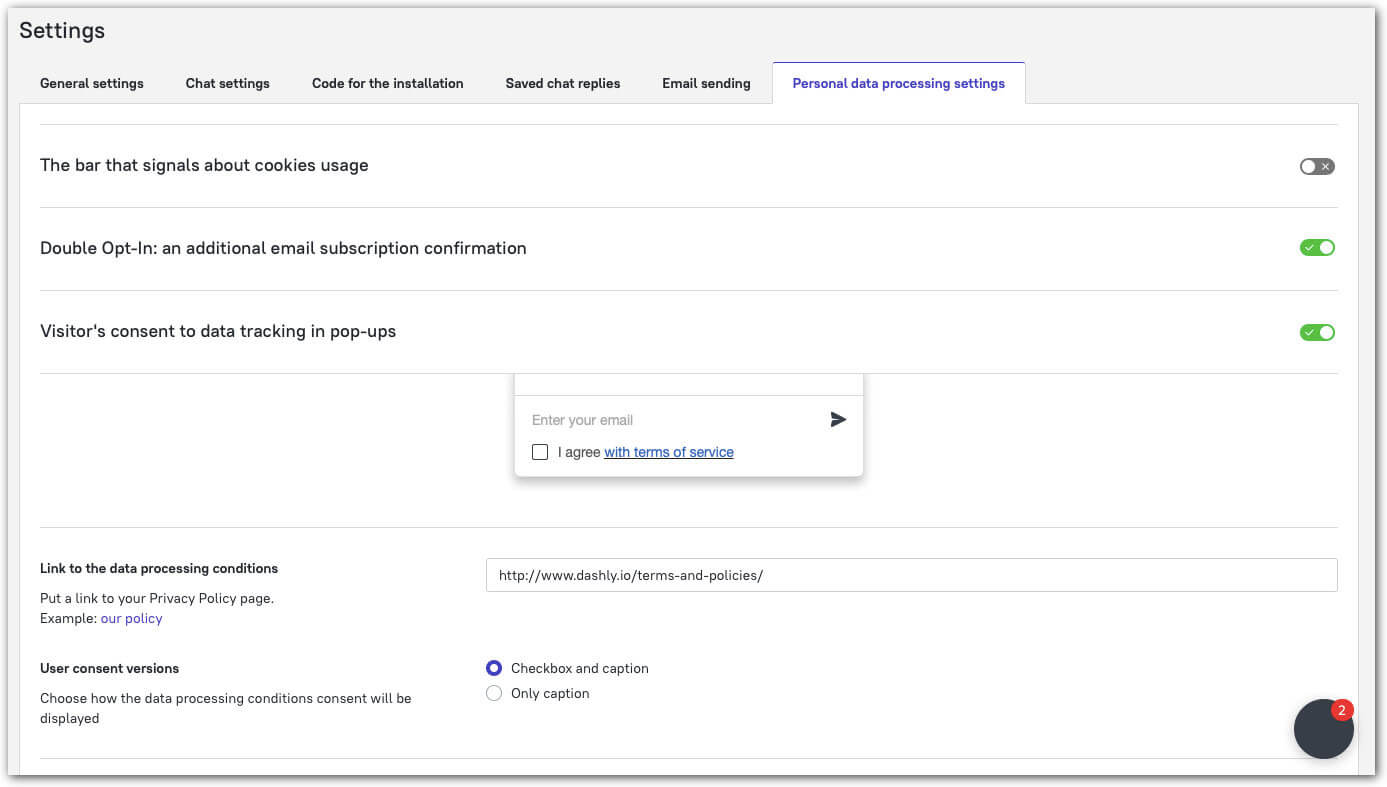
4. Provide your recipients with an option to unsubscribe
Have you ever noticed links to “unsubscribe” in the email messages you receive? As a matter of fact, you can’t send a mass email campaign without such a link. Why?
There are two reasons for that:
- If a person can’t unsubscribe from your emails, they’ll end up tagging it as spam sooner or later, which we really don’t need.
- Mailing services recognize email messages without this link and they’ll likely start seeing them as spam.
Sometimes it happens that a person just doesn’t want to receive emails from you anymore. It’s alright, don’t take it personally. Let them go.
Give your subscribers an option to unsubscribe from your emails. Place a clean and distinct unsubscribe link somewhere in the lower part of your email.
5. Unsubscribe inactive users
Your email base most likely has users who haven’t opened a single email message from you in the last 3 to 4 months. Most likely, they’re not interested in your email campaigns, or they just haven’t opened their inbox in a long time. Such subscribers are practically useless to you — they simply lower your Open Rate and they don’t need the subscription anymore. You can start a resuscitation marketing campaign, or you can just unsubscribe inactive users from time to time. This way, you’ll increase the involvement of your email base.
Sender reputation
Even if you’ve gathered your email base all by yourself, even if it’s all hot and ready for your email campaigns, that still doesn’t guarantee that your domain reputation will remain crystal clear. You must still prove to internet providers and mailing services that you’re not a spammer. That will drastically improve your deliverability.
6. Set up email authentication
There is a way to mark your domain for mailing services as a safe one. To do that, you’ll need to add DKIM and SPF records and a DMARC protocol.
DKIM is a digital signature that shows your sender reputation as a trusted one.
SPF shows what mailing servers can send email messages from your domain.
DMARC is a protocol that protects receivers from phishing using your domain.
You can add these in DNS settings.
7. Send your email campaigns from a subdomain
Don’t send your emails from your main domain (like mysite.com). Instead, connect a subdomain, (e.g., mail.mysite.com). If something goes wrong, it may save the reputation of your main domain. It would be a shame if you lost the ability to send email campaigns with your main domain as your sender name, or if your employees’ email messages stop reaching their recipients.
8. Send your first campaign as a warm up
When you’re adding a new domain (or subdomain), it’s still unknown to mailing services, so the first email campaigns sent from it will be the defining ones for its reputation. Present yourself well. Don’t send a huge campaign to several thousand people right from the start. Start by sending some quality content to a small group of your most loyal users first. If this campaign ends up having good statistics (with a lot of users opening it, clicking on links in it and replying to it), your larger future campaigns will be less likely to bounce, and if you happen to launch a not-so-successful campaign, you will be less likely to be blocked by mailing services.
It’s recommended that you increase the volume of your campaigns gradually.
For example, here’s a warm up schedule recommended by Sendgrid:
| Day | Daily volume |
| 1 | 50 |
| 2 | 100 |
| 3 | 500 |
| 4 | 1000 |
| 5 | 5000 |
You can make a survey email or an email with some curious facts: you will risk nothing this way, since it won’t be any important news on updates or events.
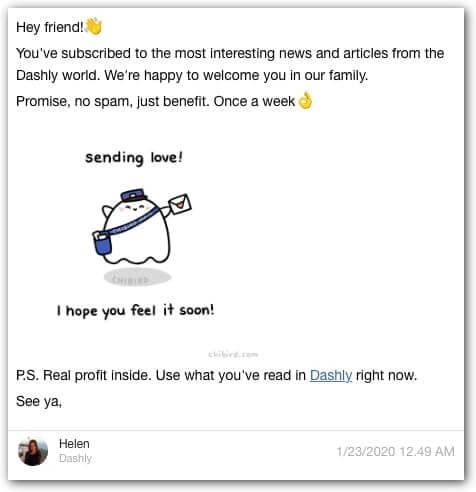
First, you might want to share it with your colleagues and ask them to open it and play around with the links it contains. Second, you can send it to your most loyal audience, for example, avid readers of your blog or regular users of your service.
Your loyal readers are likely to have a positive reaction to a campaign like this, which will give you good initial statistics. After that, you’ll be ready to send a campaign involving a wider portion of your email base.
Remember: Make sure your warm-up campaign is really interesting and helpful so that it doesn’t end up being a heap of unnecessary information to your visitors.
9. Check your sender reputation
Even if you’re doing everything right, you have to know you’re not blacklisted. Your sender reputation is made of your IP reputation and your domain reputation. You can check both online easily.
Got it. Check your email!

- You can see your IP reputation with SenderScore:
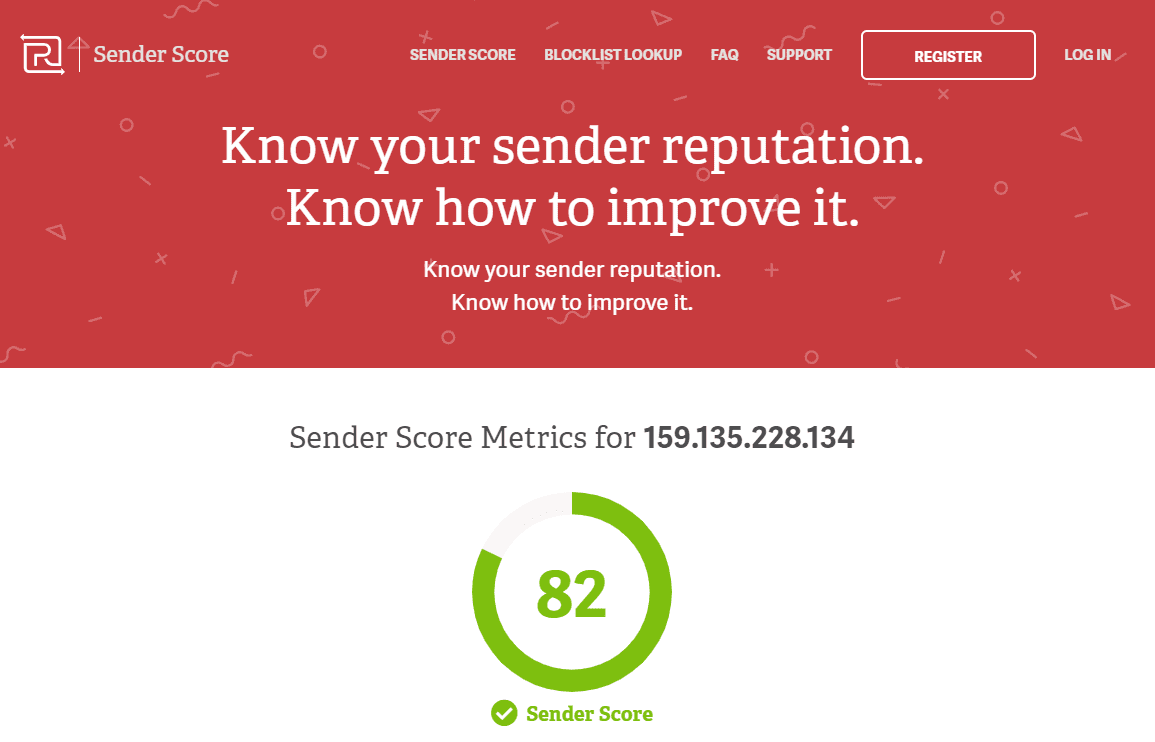
Just enter your IP and it will show you all of the information about it in detail.
- You can see your domain reputation with MxToolbox. This tool will search for your domain in over 100 different blacklists and show you who uses it to send emails. This is what an MxToolbox report looks like:
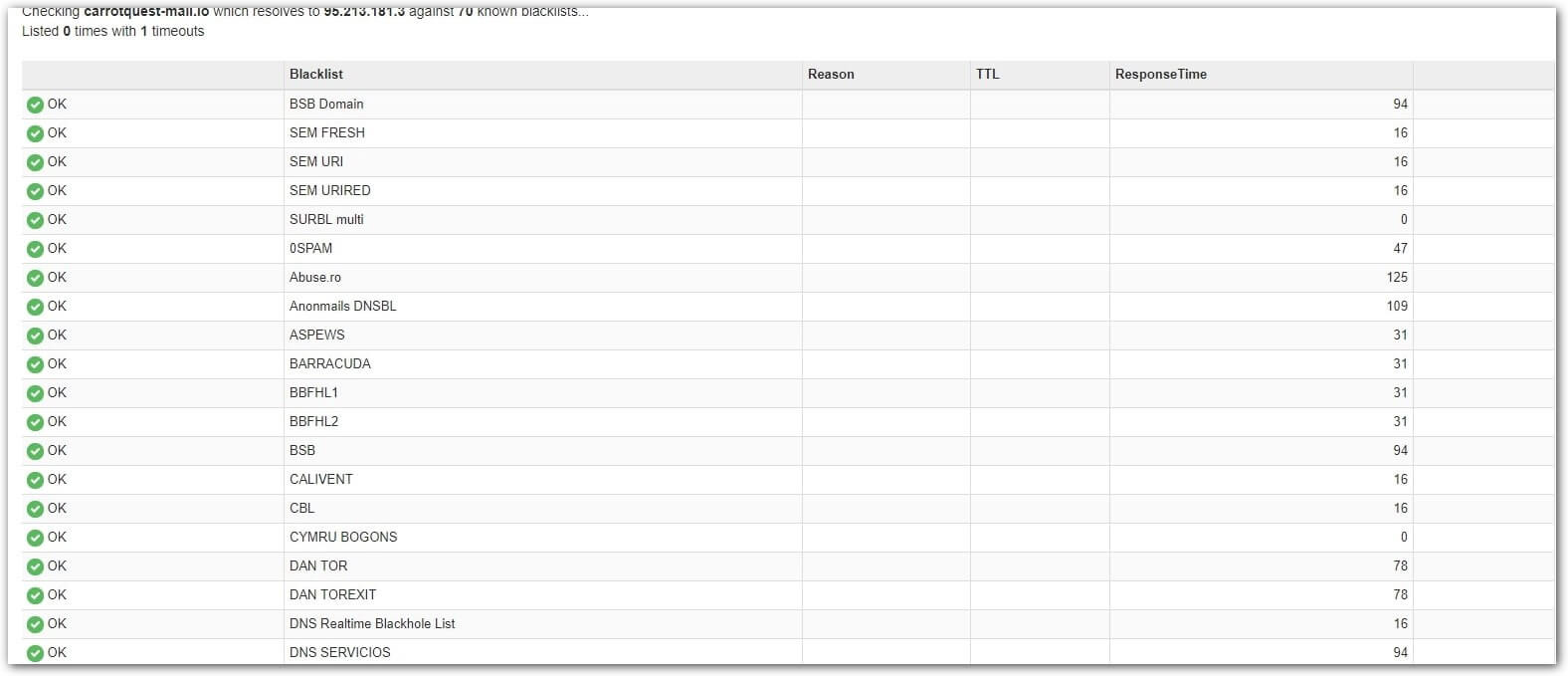
Analytics
10. Gather statistics
Keep an eye on your email campaign statistics. You can find them in the Analytics — Campaign report section.

How your visitors treat your campaigns is the best possible evidence of how successful your email campaign is. You’re doing everything right if your campaign has high read, reply and click rates. If your emails don’t reach their recipients (which is shown by a high bounce rate), or they unsubscribe and flag your emails as spam, then you might want to re-think the audience of your campaigns, or readjust its sending settings or its content or subject.
If you keep sending a low-rate campaign, you risk getting blocked by spam filters and ending up not being able to reach your visitors’ inboxes.
11. Keep an eye on the bounce rate
Pay close attention to this step because it’s crucial.
The bounce rate is a metric that reflects undelivered emails. A high bounce rate is harmful for your sender reputation. Most internet providers have a bounce rate limit, which reacts to senders breaking this limit by warning them or even blocking them.
There are two kinds of bounce rate:
- Soft bounce
This may happen if a recipient’s inbox is full, a message you’ve sent to them is too big, or your recipient’s mailing server is experiencing errors.
If it happens due to your recipient’s inbox being full, consider unsubscribing them, since this may be a sign that they haven’t checked their inbox in a long time.
- Hard bounce
This suggests an unresolvable problem with a recipient’s inbox. It happens when a recipient’s email address or domain is non-existent, or if your email gets blocked by a recipient’s mailing server.
It’s better to exclude all addresses that return your emails with a hard bounce.
Mailing services watch senders’ bounce rates and block them if they break the 5% bounce rate limit.
12. Keep an eye on the spam rate
Mailing services are strict about how their users react to emails. Too many users flagging your emails as spam is a bad sign.
Major mailing services have a spam limit; breaking it will get you in trouble. Generally speaking, make sure your spam rate doesn’t exceed 0.5%.
In Dashly, your email campaigns will be blocked if you exceed a spam rate of 0.2% in the previous 30 days. It’s less than the ones mailing services have, because we want to keep our clients safe from being blocked. With Dashly, you can fix this problem before mailing services block your domain.
You can see the spam rate in the automatic and manual message reports.
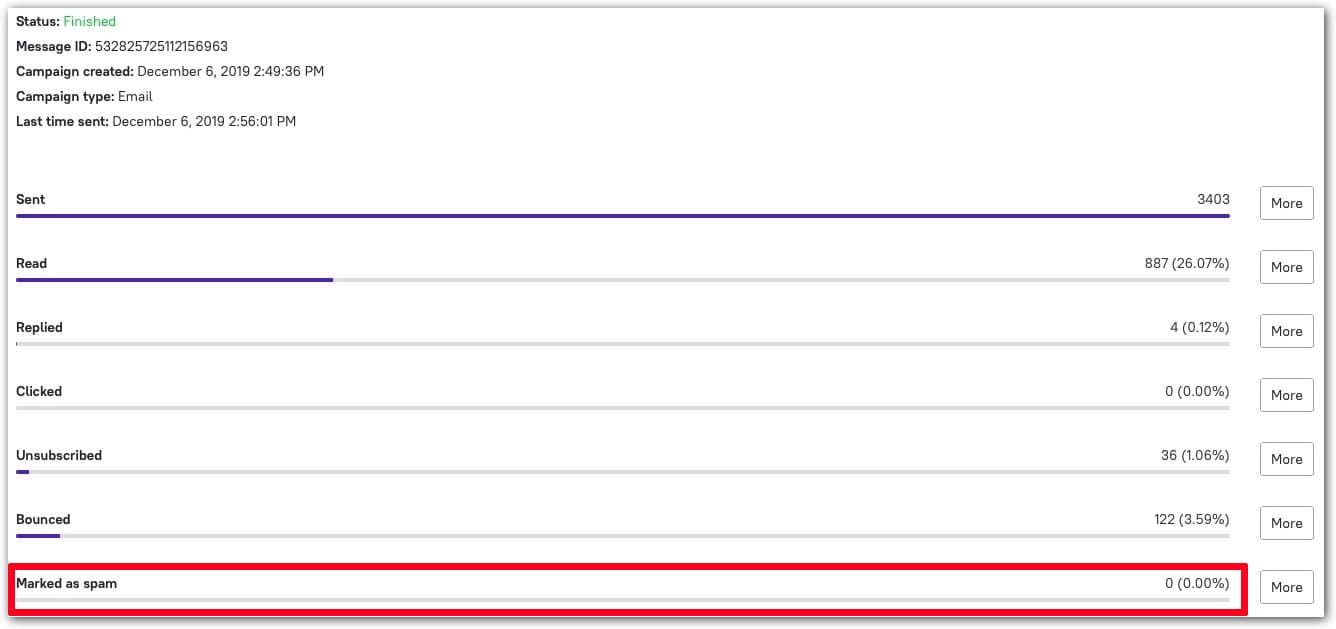
Contents of email messages
Previously, we described how you can avoid a high bounce rate and being considered a spammer by mailing services. Aside from that, users can manually tag your email message as spam, and no one can stop them from doing that. It’s hard to measure the “spamminess” of your email campaign, but you can decrease the probability of your email being placed in the Spam folder by using some common sense.
13. Get rid of spam words in the subject and content of your email campaigns
When you get a spam message, the following words will most likely signify that the contents are not worth looking at.
| Spam word types | Examples |
| Imperatives | Click Buy Download |
| Ways of getting profit | Earn $40,000 a month! $$$I GET 100,000 DOLLARS EACH MONTH |
| FOR FREE | GiftFreeSale |
| Urgency | Urgent! Important! Attention! |
| Excessive punctuation marks | Don’t do it!!! Why are you screaming at your readers??? It’s annoying!!! |
| Character replacement | 3m@iLs L1k3 7h1$ 4r3 n07 gr8 |
| Capital letters | DON’T WRITE LIKE THIS |
Examples of what you shouldn’t put in your email campaigns:
- free stuff, ways to earn something
- urgency
- character replacement
- caps lock
- syntax
- design
- layout
The worst thing you can do is use too many spam words in the subject of your email. That’s one of the things mailing systems look out for the most. You also shouldn’t use words like “Test” (if it’s not about a paternity test or attention test, which are totally allowed to mention).
14. Personalize the From field
It’s good when an email communication looks more like a one-on-one conversation. If your subscriber sees an email from a trustworthy sender, they’ll be more likely to open it.
Mailing services pay attention to how often users open the email messages they get and what sender info these emails contain.
Take care of what you write in the From field. According to research by Convince and Convert, 43% of people flag emails as spam based solely on what is written in the From field.
Here are some examples of how to do it right:
- Using specific information, like name and company name, is a good practice.
Here’s what you want to avoid using:

I wouldn’t trust these letter-number combinations if I found these emails in my inbox:

- Don’t change the info in the From field too frequently — mailing services see this as a bad sign.
- Use clear, distinct and trustworthy email addresses like “contact@”, “newsletter@”, “support@”, “feedback@” and so on.
Here is an example of sender ignoring these rules:

15. Watch the message size
According to research by Email on Acid, an email with a size of over 100 KB may be too big to reach its recipient. This only applies to the size of the HTML code itself, without the size of pictures and attached files.
Also, Gmail can shorten your email if its size is over 102 KB.
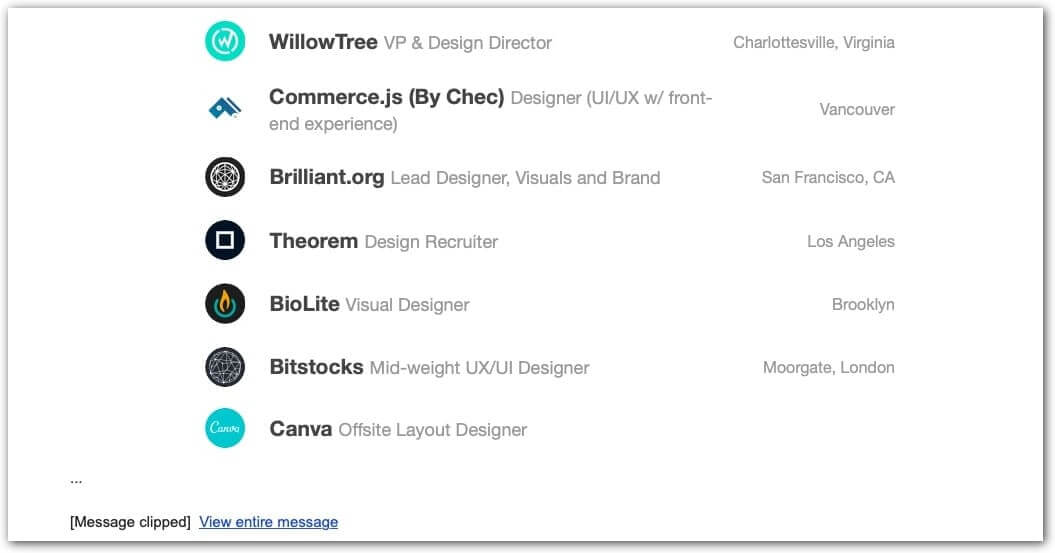
To decrease the size, try removing redundant parts of the code (the code may contain, for example, hidden formatting tags). Make sure it only has the necessary stuff.
Make sure your images have the correct size too: it will take too long for big images to load. Are you sure your visitors have time to wait for the whole message to load?
Marketing Cloud recommends using images with a size of up to 200 KB.You can choose the Light email layout in Dashly — it’s perfect for basic email messages, like chat messages your visitors receive via email, for example. Emails you create with this layout will always have a small size and will look neat too.
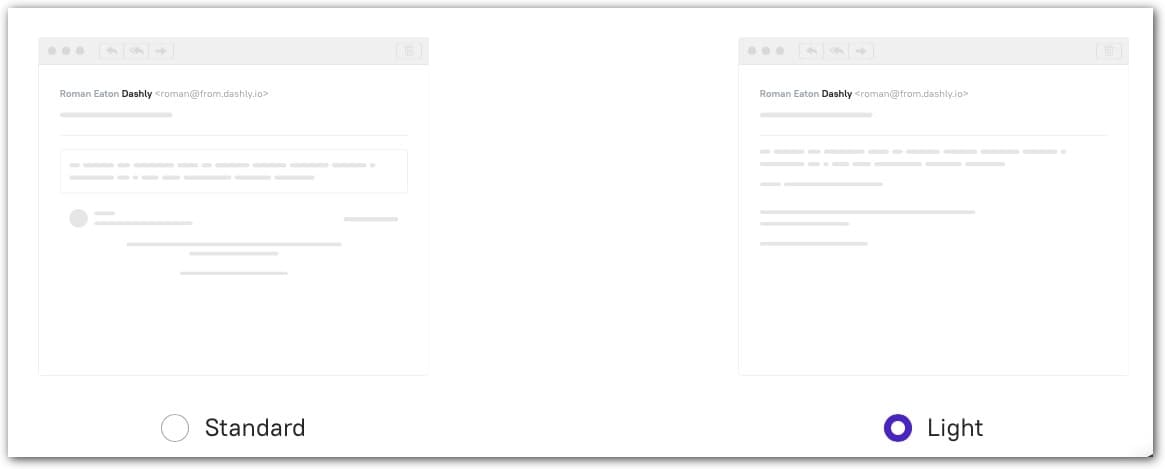
16. Optimize the text-to-image ratio
It’s pretty basic: if your email has too little text, it will be more likely to end up in the Spam folder. If your email has too few images, it will be too hard to read.
According to Email on Acid, emails with less than 500 characters of text are more likely to be flagged as spam by mailing services.
Make sure your emails include a minimum of 500 characters. If your email is shorter than that by necessity, adding an image to it will improve its chances of getting to your visitors’ email addresses as intended.
And, of course, emails containing just a couple of lines of text and a few links are sure to be hit with spam filters.
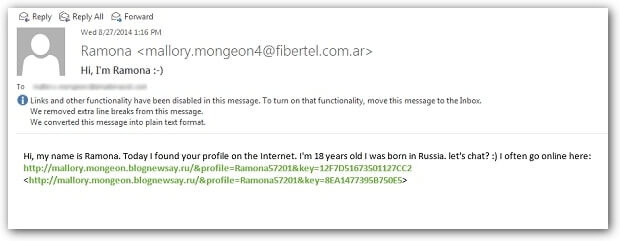
17. Avoid attaching files
Attachments increase your chances of you finding yourself in the Cemetery of Spam. Spammers frequently use attachments to send viruses and other equally unpleasant stuff.
They tell me it’s a purchase order, but I know better. This attachment is Trojan-ridden.
Using links instead of attachments is a wise choice.
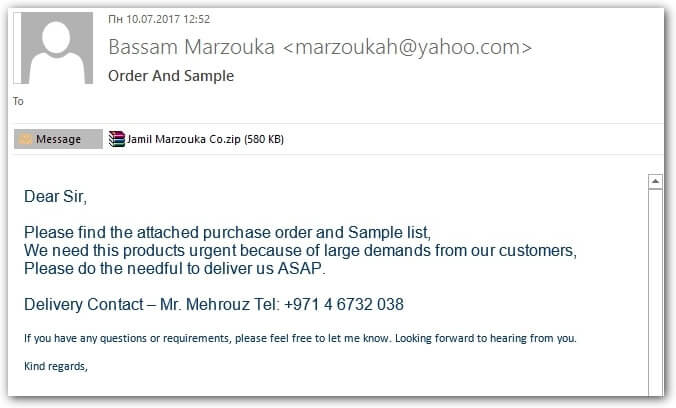

We could have sent this book with the email itself, but we didn’t:

18. Always check your URLs
Sometimes emails get flagged as spam because they contain links that lead to suspicious websites. We know your website is better than this; just don’t forget to check links to your partner projects and third-party sources you mention in your emails.
We don’t recommend using shortened links. But don’t panic: links are almost always embedded in text, so no one will notice how long they are.
19. Do A/B tests
A/B tests is a very popular marketing tool. This will help you see which variant of your email campaign works better with your audience and let you optimize your campaign. As you might have guessed, this will influence the statistics of your campaign and the behavior of the recipients. Even if we ignore the spam factor for a minute, A/B testing will help you win the hearts of your audience. And that is the main purpose of your campaigns, isn’t it?
20. Check your emails with a spam tester
We know: this is all too much information, and it must be hard to keep track of it all and measure your spam potential right away. But there’s good news too. You can use spam testers. For example, Mail tester:

But don’t forget about common sense when writing emails — many marketing emails will be marked as spam by this tool just because of words like ‘sales’, ‘money’, and so on. But this is entirely OK. ?
21. Keep an eye on your engagement rate
The last but not least point. The engagement rate is the consequence of many factors: this may be the wrong choice of the target audience, pedestrian content, etc. Anyways, the result of low open rates is that your emails are not attractive to your audience, and they don’t read this. Email services analyze users’ behavior and decide which email goes to spam or users’ inboxes.
This has already become our favorite advice, but I’ll repeat once again — try to define your buyer persona and the jobs they want to solve with your product. When matching your target audience’s needs and content, you’ll see excellent results both with engagement and spam rate.
Also, try to segment your users and send them more personalized offers. Again, you may define several buyer personas and their jobs for this. Your offers in emails will be more targeted, the ER will grow, while spam rate declines, and everybody will be happy.
Also, try to segment your users and send them more personalized offers. Again, you may define several buyer personas and their jobs for this. Your offers in emails will be more targeted, the ER will grow, while spam rate declines, and everybody will be happy.
Why is it essential to make all the users receive your emails?
Probably after reading this article, you started thinking: maybe I don’t need email marketing?
Emails are good at increasing sales on the traffic and leads you already acquired. I’ll tell you the three most popular ways.
1. Retention, please
We already told you that acquiring a new buyer is five times more expensive than holding your users. Email marketing is the most obvious tool that comes to mind when you need to increase retention. Usually, this is the only way you can engage users after the first touch with your product. What types of emails can help you with this?
- Welcome email with valuable articles or top-N popular features that can help a user solve their problem (again, don’t forget about buyer personas portrays while doing this)
- Friendly reminders. This may be an abandoned cart or features recommendations — this depends on your business industry. This is probably what the user needs right now, and the reminder with the right content can generate new purchases.
- Exclusive offers. I bet everything is evident here.
There are many other options. Don’t limit your imagination.
2. Average order value
You’re literally losing your revenue when not working on this metric.
Everything is simple. Send emails to users who just have made a purchase or to those who are willing to. Offer them some product that may complement the product they want to purchase. This tactic is not new but still works.
3. Reactivation
Remind users about you and your product. Maybe, you have some new features that will be interesting to your users and bring them back? Or you started a sale in your online shop?
In conclusion
TL; DR, use the appropriate email campaign etiquette. Only address those who are expecting emails from you (i.e., those who actually gave you their addresses), provide people with a possibility to unsubscribe from your emails, and don’t go too hard on links, images and spam words. Bring useful stuff with your emails and make sure they perform well statistically. Good sending!
| This article was first published on Jabuary 23, 2020. April 19, 2021, we’ve updated it. |
Read also:
- Top 13 follow up email software to elevate your email marketing strategy
- 10 best predictive lead scoring software to boost your sales funnel





